This article reports on a collaborative project inaugurated in a Creativity Workshop in the University of Canberra. It explores how the work of the French social philosopher Pierre Bourdieu is useful to creative artists and writers. The empirical focus is a piece of historical fiction—The Dishonest Woman—set in c16 Antwerp. Bourdieu is used in three ways: to map the social context of the novel; the actual field represented; and the place of the author within the contemporary literary field. This work represents a further step towards founding a ‘reflexive aesthetics’ in the creative arts.
Introduction
The French social philosopher, Pierre Bourdieu, established himself as a major cultural theorist in a career that lasted over 50 years. This influence did not end with his death in 2002, and has continued to develop in several directions since then. This article is one such development, and it explores the way in which his work can be used within the creative arts—in this context, writing literature; the justification for doing so; and what such an endeavour provides. Part I sets out the rationale for our project, based on an application of the social epistemology of aesthetics as formulated by Bourdieu. Part II outlines the practical application of Bourdieu’s tools in the development of an historical novel; and Part III is a discussion on what the project has revealed so far, and what this may bring to the craft of creative writing.
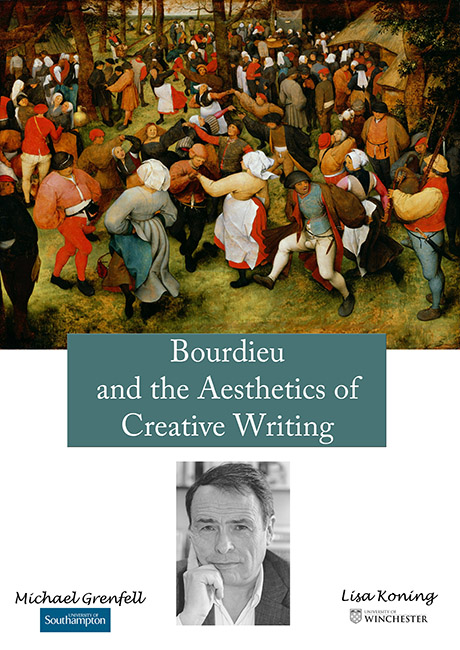
Part I: Theoretical Background
As a social theorist, Bourdieu’s work is mostly recognized in terms of cultural patterns of consumption: photography (Bourdieu et al. 1990a), museum attendance (Bourdieu et al. 1990b), and French ‘taste’ (1984). But such only covers a fraction of his work on what he termed ‘the cultural field of production’ (Bourdieu 1993a), which includes analyses and studies of fashion, television and media, journalism, sport, language, music and religion (see for example, Bourdieu 1993b). He also analysed the actual production of art, with later large-scale studies of the writer Gustave Flaubert (1821–1880) (Bourdieu 1996) and the pre-impressionist painter Edouard Manet (1832–1883) (Bourdieu 2017). Principal issues here are the extent to which such artists create their audience—indeed somewhat reflect them—and thus the status of their cultural works. Are they self-serving egoists intent on financial gain, or ‘heroic’ critics of social conservatism? Somewhat to answer this question, in a later discussion with fine art students at Nîmes, Bourdieu insists that his brand of sociology can be useful to practitioners in the creative arts (see Bourdieu 2016). How so?
Our understanding of the processes of creativity and talent are deeply rooted in the philosophy of the founder of modern metaphysics, Emmanuel Kant (1724–1804) (see Kant 1956; 1971; 1987). Kant posited the relationship between the human faculties of reason, knowledge and understanding, and what he considered to be the ‘aesthetic experience’. For Kant, the latter needed to be understood in terms of the ‘pure’ or ‘disinterested’ gaze, a kind of transcendental view of art and the creative experience. If this were true for the consumer of art, it was no less so for its producer. At the base of this phenomenology of aesthetic experience is nothing less that the nature of the relationship between the subject and the object;[1] in other words, the individual (subject) human capacity to engage in the life-world (in this case of creativity) and the objects (art works) instantiated within it.
Contra Kant, Bourdieu could not see such subject-object relationship as somehow ‘transcendent’ but, rather, as the very expression of pre-existent social world, replete with its own differential value systems and individual interests. For Bourdieu, everything was in the nature of that structural relationship between the subject and that object, and the way their interaction was constituted by social norms and the generative structural forms, which underlay them (see Grenfell & Hardy 2007). One consequence of this argument is that art is simply another form of social differentiation and distinction, and thus is characteristic of those producing and, indeed, consuming it. Bourdieu’s ambition is to develop a new ‘science of aesthetics’, which uncovers such social derivation in art as a way of developing another aesthetic informed by a reflexive relationship to the subject and object of artistic production and consumption. This ‘science’ is based on a series of breaks from various orthodox philosophical traditions in art and creativity, and the foundation of a ‘science of dialectical relations between objective structures … and the subjective dispositions within which these structures are actualized and which tend to reproduce them’ (Bourdieu 1977: 3). In effect, the approach amounts to objectifying the relationship between the subject and object of art, and indeed the nature of that objectification itself. The latter can take place in terms of any one individual’s (naïve) personal disposition, but Bourdieu argues in terms of a specific methodology, one itself based on the same epistemological principles of structures as both structured and structuring.
In practice, we can understand the approach as consisting of three co-terminus ‘phases’ and ‘levels’ (see Grenfell 2012, chapter 13). First, there is the ‘construction of the research object’, in this case, creativity and the cultural product. This stage is intended to break from conventional orthodoxies of approach and found a new ‘gaze’—or metanoia—towards it.
Second, the whole study then proceeds according to three ‘levels’ of field analysis. For Bourdieu, the subject and object are reconfigured in terms of habitus and field. Habitus is the constituent of subjective disposition, relations, etc. derived from an individual’s biographical trajectory; whereas field is a bounded space of social activity: for example, the art field, or the education field. Bourdieu targets any one field and its relationship to the field of power—e.g., government, commercialism, the state, commerce; the structure of the field itself; and the habitus of the individuals who hold distinct positions within it. Central to any ‘field analysis’ is what is valued as currency within it. Bourdieu expresses such in terms of capital, and there are three predominant forms: cultural—education, taste, cultural objects; economic—money wealth; and social—network relations between individuals with valued positions within the field. Any one field can then be studied in terms of its characteristic quantities of capital and the relative forms it takes, and the habitus of those involved within the field—and, indeed, the ongoing relationship between the two.
Because Bourdieu’s is a ‘relationalist’ rather than ‘substantialist’ philosophy (see Cassirer 1953/57), he argues that the same approach also needs to be taken to both the subject and the object of research; namely, the researcher and the researched. The third phase of his approach is therefore reflexivity, expressed as Participant Objectivation. Here, the same tools of analysis—habitus, field, capital—that are brought to the research are also brought to the researcher as a sort of ‘objectification of the objectifying subject’ (see Bourdieu 2003). Any individual researcher comes to their research with embedded biases (see Bourdieu 2000: 10ff). These may be both personal and/ or professional; participant objectivation is a means of rendering these explicit as a way of declaring ‘the limitations of thought’ rather than reifying it as ‘knowledge without a knowing subject’ (see Popper 1972).
The development and application of this approach in terms of techniques and epistemological vigilance clearly amounts to a significant alteration of the relationship between artistic subject and object—in research and, potentially, within the creative arts. This article is really about the implications of this alteration when effected in the relationship between the subject and object of the creator and created in writing (in this case) historical fiction. The next part considers this project from three distinct perspectives: the fields of the time period in which the fiction is set; a field from the novel itself; and the field of the writer in her own times.
Part II: Creating a novel
Any author embarking on a work of historical fiction faces challenges when it comes to research, and the novel in this project was no exception. The Dishonest Woman is set in sixteenth-century Flanders, and very quickly the extensive amount of information available indicated research would be a very large undertaking. The artefacts and ‘facts’ revealed during any research activity are often conflicting, sometimes inconclusive, and regularly contain substantial gaps. Recorded history often focuses on the official records. However, the unofficial histories—such the stories of minorities, and women—are very often lost. For an author, interested in the details of daily life, such information is invaluable. At the Great Writers Conference in London, Bryony Stocker’s advice in her presentation on ‘A historiography for historical fiction’ was Don’t lie (verbatim account, Stocker 2018). However, when it comes to history, the truth can be elusive. For example, in studying a painting by Pieter Bruegel the Elder as research for the novel, it was revealed that aspects of the work had been altered; possibly by the artist himself but why is unknown. Deciding what is the truth when faced with such a situation and no definitive explanations leaves the writer having to construct a history themselves—which, of course, is one of the tasks of a writer of fiction. The challenge arises when the writer is keen to re-create a world based on a specific historical period. What is needed is a way to approach the research; a method or methodology, to manage the various facts and ideas uncovered, not as a historian but as a writer.
Using Bourdieu’s perspectives in looking at society as outlined above is not at odds with a writer’s aim of creating credible characters, settings and events, such as can be seen with a project like The Dishonest Woman. Rather, it should enhance the writer’s aim in bringing together character, context and story. The objective of this novel was to bring to life the world as painted by Pieter Bruegel the Elder, giving a voice to characters depicted over 500 years ago. Here, Carnival is a key theme with its sense of a world ‘turned upside down’ (see Grenfell 2018), but to depict historical characters and events, an understanding of how and why people behaved, from a socio-cultural point of view, helps create depth and a sense of realism. Behaviour is complex, and often governed by greater forces at play, which are actually living contexts of Bourdieu’s fields. Changes are happening within the world, both close at home and further afield, and writers are interested in what influences how people lived, the decisions they made and the major concerns for society and communities at the time. For Bourdieu, these are issues of habitus, its dispositions and the field contexts within which individuals play out their lives. Applying a more sociological approach to the task of researching and writing a novel, therefore, opens up many possibilities, enabling the writer to construct a view of how society lived and operated in its day.
The next section explains how Bourdieu’s approach illuminated the creative writing from three perspectives: with respect to the research background of the novel, Bruegel the Painter, the field of power within the novel, and finally the contemporary field of the writer.
a) The Research Background – Bruegel the Elder
At the beginning, a useful point at which to set out was to consider the habitus of Pieter Bruegel the Elder, as a painter living in Antwerp in the sixteenth century, the period in which the novel is set. Although the exact date of Bruegel’s birth is unknown, it was around 1525 and (probably) near Breda. Basic facts about his life are simple enough to discover. He married the daughter of a prominent painter and was admitted as a free master to the Guild of St Luke’s. In Bourdieusian terms, this background accounts for his positioning with the field, or symbolic power.[2] His guild played a significant role in the city, due to the number of members compared to the size of the population at the time. Understanding the community in this way begins to develop the cast of characters as well as the setting for the novel.
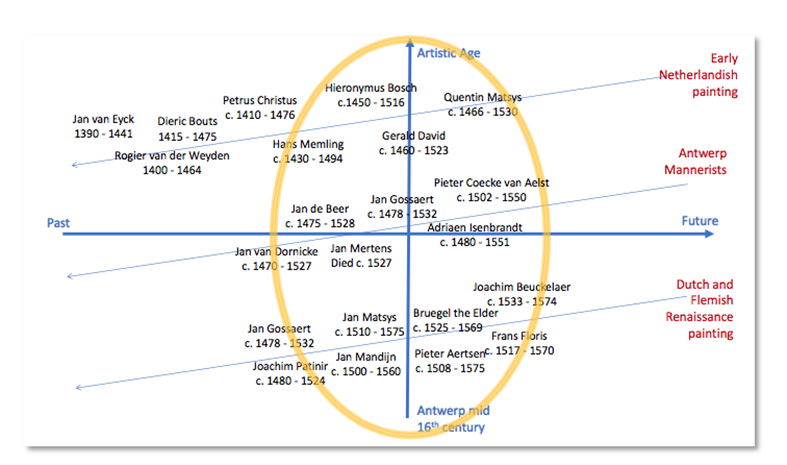 Figure 1: Field of Painters in Antwerp around mid sixteenth century
Figure 1: Field of Painters in Antwerp around mid sixteenth century
The list of 270-plus active painters in Antwerp at this time reveals little about their interaction, authority, or influences. However, the map (Figure 1) begins to depict a vibrant community undergoing much change. This figure is similar to one produced by Bourdieu and adapted for this project (see Bourdieu, 1996/1992, chapter 3). It is a static representation of what is a dynamic and ever-changing process: should the diagram be produced 100 years later, some of the same artists would remain, as they continue to be recognised (consecrated). Typically, an artist would enter at the bottom of the diagram and, as their talent and reputation grew, they would move along the line heading upward. In the case of this analysis, it is focused on the period around 1650 and at this point Bruegel is a recognised artist; that is, he has an acknowledged position within the field. To map all painters in Antwerp during this period would be a massive undertaking. However, for the purposes of this research, an excerpt is offered on a small scale to explore the inner dynamics of the art field. The placement of the painters on the horizontal lines is based on the initial research and driven largely by when they joined the guild, and the date of their death. There are some painters included on the lines who are better recognised today than others, such as Hieronymus Bosch and Jan van Eyck (consecrated capital). Of interest for the novel’s story line are the influencing forces that impact on the painters, what is driving this community, and compelling their location within the field. For the writer, this provides insight into the social dynamics of painting production in Antwerp at this time. In effect, this field analysis unfolds and fills in the gaps in the historical research available to the novel.
Working further with Bourdieu’s concepts, Bruegel’s impact on the field can be considered in terms of actual painting style and treatment of subjects. For example, his depiction of peasants was one aspect explored, chosen because it is a key characteristic of his work.
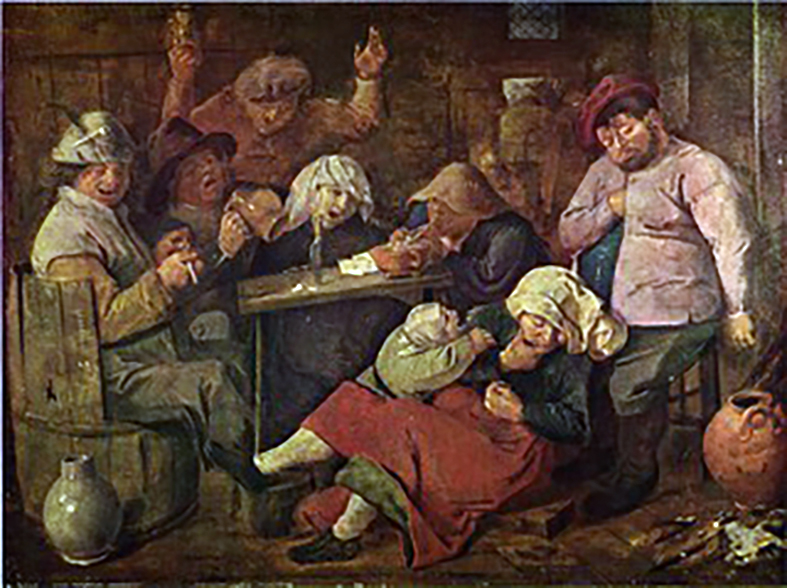 Figure 2. Inn with drunken peasants, c. 1626, Adriaen Brouwer
Figure 2. Inn with drunken peasants, c. 1626, Adriaen Brouwer
Figure 2 is a painting by Adriaen Brouwer, and is typical of paintings of peasants during the sixteenth and seventeenth centuries. There are a number of aspects that are noticeable: the faces are identical, many seem to be drunk or asleep, they play games, and the mother at the front is uninterested in her child. All of this needs to be read in terms of their symbolic depiction as a reflection of the sentiments and attitudes of the day (the aesthetic nomos).
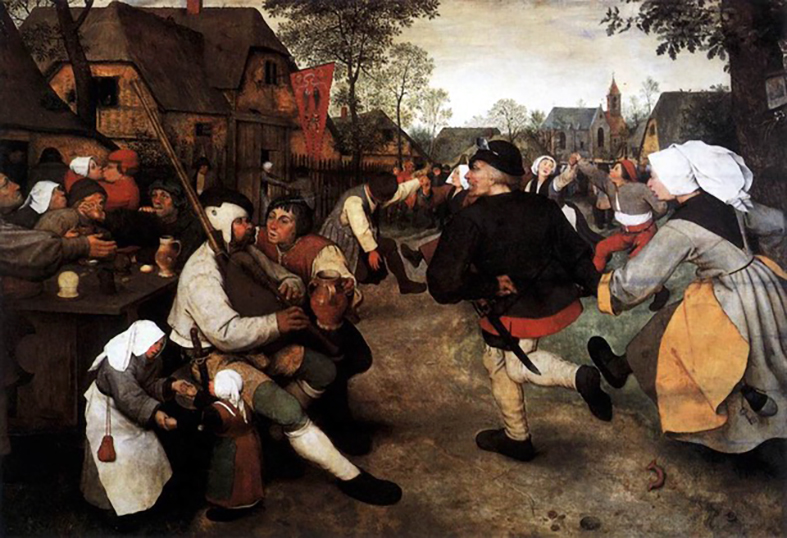
Figure 3. The Peasant Dance, 1568, Pieter Bruegel the Elder
In comparison, Bruegel’s painting of peasants in Figure 3 was produced 50 years earlier than Brouwer’s painting and is distinctly different. Of note is that people have individual faces, and they are celebrating an occasion. Bruegel is clearly reflecting another view of peasants and peasant life, which indicates how the aesthetic values changed form during this period. For a writer, what is noticeable is not just the depiction of peasants and how they might have lived, but how the lower classes more generally were perceived. It raises further questions, such as what was happening in society that resulted in Bruegel choosing a departure from the typical artistic depictions. An understanding of the various fields in which Bruegel operated, beyond that of painting production (for example, commerce and humanism), starts to establish his world as one that is complex and multi-layered and prone to capital movements and field changes. Taking into consideration Bruegel’s habitus, a picture of the man begins to emerge, one a writer can craft into a character reflective of the period. Bourdieu’s tools therefore are a means by which the author can take raw research material and begin to open up places and events, and craft characters.
b) The Novel
Applying Bourdieu’s ideas to the research was one aspect of the project. There was also the potential to apply such methods to the actual novel itself, and the world that was under construction. This section will focus on two aspects: the capital of the main protagonist of the novel, and the main field of power within the story.
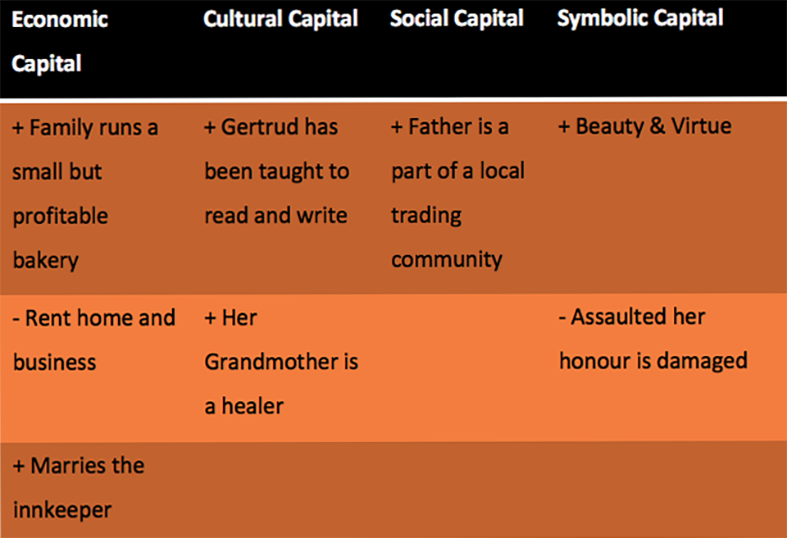 Figure 4. Capital of Gertje Vermuelen (main character)
Figure 4. Capital of Gertje Vermuelen (main character)
Figure 4 indicates how using the concept of capital helped both to construct a character’s backstory and to establish her place in society and the impact of events that take place. Gertje (the heroine of the story) is the daughter of a baker, and her family run a small bakery which brings in the family income (economic capital). As a woman of the sixteenth century, her power and influence are extremely limited, and she is dependent upon the men in her life to support her. But she gains knowledge (cultural capital) and she is beautiful, which is itself capital (symbolic) for a woman of this time. However, when she is assaulted and her honour damaged, her symbolic capital is negatively impacted. She subsequently marries an influential innkeeper, which provides her with social capital. Eventually, she also becomes an agent in the field herself, as she uses her capital to gain power over other agents in the field. And so Bourdieu’s fields become central to developing the events in the story.
Using Bourdieu’s tools further enabled the construction of events and themes that reflected the forces at play in sixteenth-century Flanders. For example, the Bourdieusian concept of symbolic violence[3] was used to demonstrate how a local innkeeper could use his influence to force marriage on the protagonist. Her father’s refusal the marriage proposal because of his loyalty to his daughter can be seen in terms of Bourdieu’s concept of inalienable values.[4] When her grandmother, rather unusually, has influence over powerful men in the city, she does so because she knows the doxa (or rules of the field) and indeed, is an agent of the field herself.
The field of power is another important component in the novel. The story is set in the heart of Antwerp, and central to any city at this time is the Grote Markt (or central market). It is a social space where everyday transactions occur and where all people, rich and poor, come together in different ways. Ultimately, to govern the central market is to rule the city, and this has become a major theme in the novel, with ten powerful men who together rule over Antwerp. Deciding on the identities and professions of these men was an important decision in constructing the field of power of the day for the Antwerp of the novel.
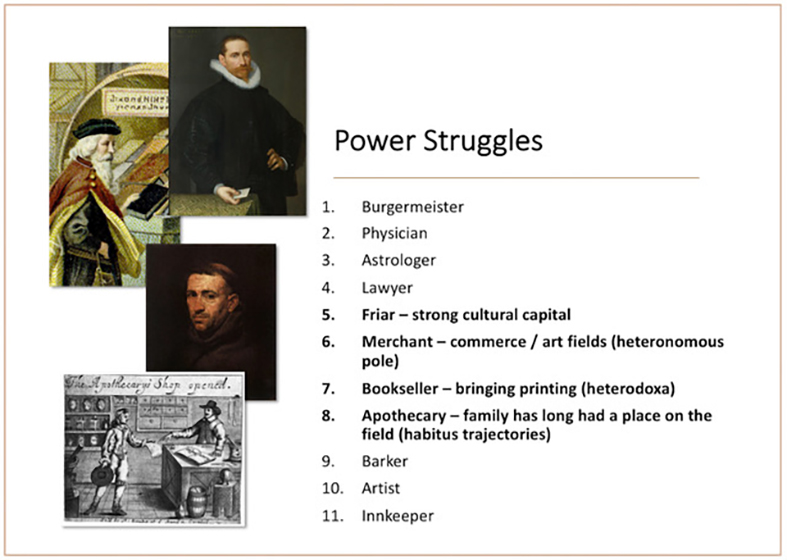
Figure 5. Field of Power
Figure 5 sets out the ten men, described by their profession as part of the field of power. We see that the Burgermeister is the most powerful and, to use the Bourdieusian term ‘illusio’, he ‘knows the game well’ and believes he can manipulate it to his benefit. He has the necessary capital to rule the city, which brings him power and influence. The least powerful is the Innkeeper. He is in the field because he is useful to the other men. However, the fact that he is in the field at all is unusual and, potentially, he is struggling to remain there. Nevertheless, he does have capital, for example, in the form of important knowledge concerning the other agents in the field, which gives him influence. In the middle of the field are numerous power struggles. As with any field, individual placement is dynamic and constantly changing. For a writer, there is a huge potential to weave such a tense situation into the story line. For example, the Bookseller is new to the field. With the introduction of the printing press, Antwerp played a prominent role in providing new forms of public communication. He is disturbing the field with a new technology and threatening the position of other more traditional professions, for example, the astrologer and the apothecary. Others, such as the carnival barker, have only limited influence and their position is tenuous. All depends on the agents’ positions in the field and the capital that they wield. The ten men in the field of power in the world of the novel indeed have a ‘currency’ beyond mere wealth. Each has something of value that attracts capital to them; although the field is always changing and needs to be seen as a dynamic social universe, so what counts as currency one day, can be displaced and devalued the next. An agent can potentially find themselves no longer on the field (see Bourdieu’s concept of hysteresis in Grenfell 2012).
These are just a few examples of how applying a Bourdieusian view to the research provided ways into the basic research information available to the novel that reveal complex relationships. This approach enables the author to identify aspects of characters’ behaviours and reactions, and this information can be used to create depth for the characters, and fabric for the settings, together with realistic plot events that reflect what was a complex world at this time. This way of constructing a novel points in the direction of what we referred to earlier as a Bourdieusian ‘science of aesthetics’. It offers much potential for a reflexive relationship to both the artistic subject and object of creative production.
c) The Author
As noted above, key to Bourdieu’s approach is Participant Objectivation, which requires the individual and combined practice to be understood in terms of the doxa (or rules) which govern them both. As a writer of historical fiction, the first logical field to consider is that of historical fiction itself, yet the enormity of the field, with its numerous sub-fields quickly becomes apparent. As defined by the Historical Novel Society, these sub-fields include alternate histories, pseudo histories, time-slip novels, historical fantasies and multiple-time novels.
To become an agent, or active player, within a literary field, a writer must develop the relevant habitus and capital forms. The process begins with learning the craft of writing itself, which may include attending university and gaining formal qualifications. It evolves from learning the doxa, such as how to write, and novel construction, through to navigating the publishing process, and covers all aspects of the field operations. The author will be interested in the larger literary field itself, which is made up of publishers, literary agents, editors, booksellers, critics, book clubs, writing programmes, journals, newspapers and magazines, professional associations, and finally, other writers and readers. Writers do not exist in isolation but work within social situations that are governed by a set of objective social relations the structure of the field itself. Depending on the type and amount of capital a writer possesses—social, cultural and economic—they will occupy different positions within the literary field. Capital can be represented by sales and royalties (economic). It can also include cultural capital such as reputation and knowledge, or even social capital (belonging to a reputable network of experts) or indeed symbolic capital (prestige & status, for example, having won a notable prize).
With such information, authors can begin to consider their own position in the field or, if new, how to enter the field itself. The author of this novel considered capital such as qualifications and additional recognition, including competitions and awards. Understanding the wider field, such as literary agents and publishers, means the writer can approach those most likely to be interested in their work, while continuing to build on social capital by presenting at conferences and being a member of a writer’s group.
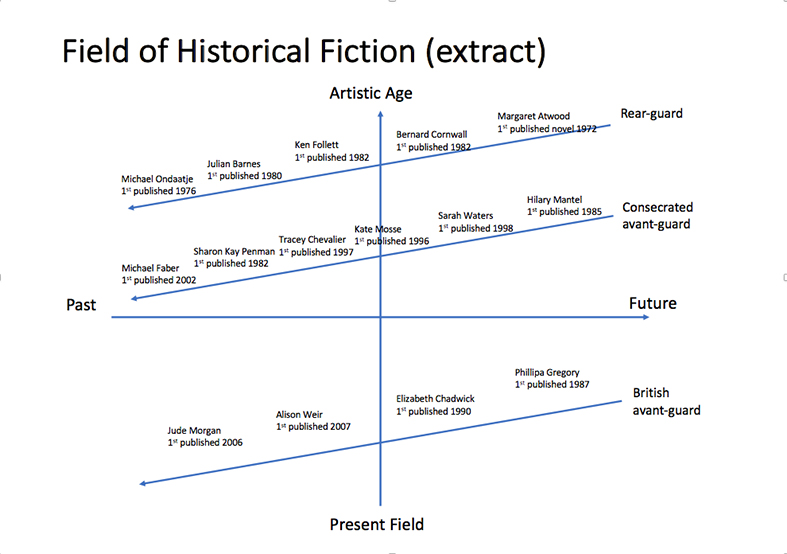
Figure 6. Field of Historical Fiction (extract)
Figure 6 is an extract based on highly successful authors who write historical fiction in a style and approach with some similarity to the author. As a writer, it is helpful to understand something of the field that you aspire to and gain an appreciation of what the market demands.
Part III – On reflection
By employing Bourdieu conceptualisation of field, including its capital currencies and the habitus of individuals involved within it, both the context and the drafting of the novel are opened out to reveal a number of underlying and countervailing social dynamics. As a method, the undertaking therefore provides insights into fiction writing, its contexts and processes.
First, a huge area of history is rendered subject to interpretation through graphic representation, which offers a social taxonomy of the day. As such, and second, it also provides a stable framework within which the creative act can locate itself. Third, a sociological approach to creative writing therefore offers insights into the social forces at play between its characters and influences in society in general. This possibility, fourth, helps develop both characterisation and event. Finally, it also gives rise to specific themes emergent within the historical époque, all of which are liable to fictional development.
However, taking up the arguments on aesthetics raised in Part I, it is also possible to see these analytical encounters as moving towards a re-founding of the relationship between the creative subject and object (author and fiction). The common view of creativity is that it emerges from a God-given talent; such is the Kantian view with its suggestion of transcendent purity, as it arises from a sublime realm of hyper-reality. No wonder it is so often expressed in terms of ‘spirit’ and ‘genius’. Bourdieu’s approach sets out to question this position. As noted, for him, aesthetics can only arise within socially constituted contexts, with pre-determined value systems endemic in the differential structures of society. This is why he insists on a ‘reflexive approach’ to cultural production, so that the producer (subject-habitus) does not simply reproduce their own relationship to the object of creativity in an unmediated way. The means to do this is the type of ‘objectivation of the objectifying subject’ where the same epistemological tools are applied both to the subject and object of research (writing) and, in this case creativity. So the author objectifies their current position within the field and, by doing so, a different sort of artistic subject is ‘torn out’ of and formed in contrast to the empirical (naïve) subject, offering a different sort of ‘reflexive’ relationship to the creative act.
None of this is captured or applied in an instant, or in a once and for all manner, but is an unfolding developmental process throughout the life of the project. Such a process took place for Bourdieu himself: from his initial empirical experiences, to the early formulation of key concepts, and then the gradual deepening of insight and understanding as to what they provide. What is offered here is, consequently, at one stage along the way in the exploration and establishment of a distinct aesthetic. Nevertheless, it is possible to express such stages in terms of sequential levels: for example:
Level 1:
- Use of Key Concepts—for example, habitus, field, capital—to animate artistic practice.
Level 2:
- Planning a creative activity systematically from a Bourdieusian theory of practice. A common focus here begins with the biographical and social space (habitus) and works up.
Level 3:
- More Critical Approach to Creative Activity—a sustained attempt to do so in terms of cultural field and fields within fields. Mapping the fields is critical and relations with individual habitus.
Level 4:
- A greater consolidation of the three phases and the three levels with a more sustained reflexive relationship—participant objectivation—to creativity.
Level 5:
- Developing a fully formed praxeological attitude—metanoia—to all aspects of artistic practice.
Level 6:
- Internalisation of the theory of practice at an individual subjective level: the epistemology becomes an individual ontology. The empirical artistic habitus is increasingly superceded by an ‘objective’ aesthetic habitus. At this point, the carriers of the epistemology—the key concepts—begin to fade.
Level 7:
- Emergence of Objective Art—an Objective Reflexive Aesthetic—as a singular and group artistic consciousness.
What this scheme embodies is both the application of this epistemological vision to the act of creation and the consequent formative influence such can have on the individual artist/ writer. Nevertheless, the term ‘level’ should not be read in a ‘linear’ or ‘utilitarian’ way, but as in potential towards what is possible within creative practice. Bourdieu is, therefore, creating the ‘conditions of possibility’ for such a way of working and seeing. Ultimately, it is less a question of having a creative subject (writer-artist) who does not make themselves an object (work of art) in an unreflexive way, and more a case of such creative work emerging from a different, epistemologically informed subject (habitus-writer). The aim is not to replace an unobjectified artistic action with a sociological deconstruction of the same, but to find a genuinely new relationship between art and the subject of its celebration. This article has offered a beginning in charting the course towards such a ‘reflexive aesthetics’, as part of a ‘science of aesthetics’ of immanent sentient impulses within trans-historical social fields.
[1]. Bourdieu’s key terms and concepts are retained in italics to remind the reader that his is a special interpretation and application of them: see Grenfell 2012.
[2]. Symbolic power is the power an agent on the field possesses ‘in proportion to their symbolic capital, i.e. in proportion to the recognition they receive from the group’ (see Grenfell 2004: 28).
[3]. ‘According to Bourdieu, contemporary social hierarchies and social inequality, as well as the suffering that they cause, are produced and maintained less by physical force than by forms of symbolic domination. He refers to the results of such domination as Symbolic violence’ (see Grenfell 2012: 179).
[4]. Inalienable values: ‘Values that are held to be intrinsic to a person and not subject to the values of any field, such an honour, loyalty and family allegiances’ (see Webb, Schirato and Danaher 2002: xiii).
Bourdieu, P 1977/1972 Outline of a Theory of Practice (trans R Nice), Cambridge: Cambridge University Press; Esquisse d'une théorie de la pratique. Précédé de trois études d'ethnologie kabyle. Geneva: Droz
Bourdieu, P 1984/1979 Distinction (trans R Nice), Oxford: Polity; La Distinction. Critique sociale du jugement. Paris: Editions de Minuit
Bourdieu, P, with L Boltanski, R Castel, and J-C Chamboredon 1990a/1965 Photography: A Middle-brow Art (trans S Whiteside), Oxford: Polity; Un Art moyen, essai sur les usages sociaux de la photographie. Paris: Les Editions de Minuit
Bourdieu, P, with A Darbel and D Schnapper 1990b/1966 The Love of Art: European Art Museums and their Public (trans C Beattie and N Merriman), Oxford: Polity; L'Amour de l'art, les musées d'art et leur public. Paris: Les Editions de Minuit
Bourdieu, P 1993a The Field of Cultural Production: Essays on Art and Literature, Oxford: Polity
Bourdieu, P 1993b/1980 Sociology in Question (trans R Nice) London: Sage; Questions de sociologie. Paris: Les Editions de Minuit
Bourdieu, P 1996/1992 The Rules of Art (trans S Emanuel), Oxford: Polity Press; Les règles de l'art. Genèse et structure du champ litéraire. Paris: Seuil
Bourdieu, P 2000/1997 Pascalian Meditations (trans R Nice), Oxford: Polity; Méditations pascaliennes. Paris: Seuil
Bourdieu, P 2003 ‘Participant objectivation’, Journal of the Royal Anthropological Institute 9.1: 28–42
Bourdieu, P 2016/2001 Thinking about Art—at Art School (trans M Grenfell), Canberra: Centre for Creative and Cultural Research, University of Canberra; Penser l’art à l’école. (ed. Inès Champey). Acts Sud: Arles.
Bourdieu, P 2017/ 2013 Manet: A Symbolic Revolution, London: Polity; Manet: Une Révolution symbolique. Paris: Seuil
Cassirer, E 1953/1957 Philosophy of Symbolic Forms (trans K Mannheim), Newhaven: Yale University Press
Grenfell, M (ed) 2012 Pierre Bourdieu: Key Concepts (2nd ed), London: Routledge
Grenfell, M 2018 ‘Bourdieu, Bahktin and the aesthetics of the carnivalesque’, Axon: Creative Explorations, Issue C2: Inside/Outside/Carnival,
Grenfell, M and Hardy, C 2007 Art Rules. Pierre Bourdieu and the Visual Arts, Oxford: Berg
Grenfell, M 2004 Pierre Bourdieu: Agent Provocateur, London: Continuum
Kant, I 1956/1788 Critique of Practical Reason, New York: Liberal Arts Press
Kant, I 1961/1781 Critique of Pure Reason, London: Macmillan
Kant, I 1987/1790 Critique of Pure Judgement, Cambridge: Hackett
Popper, P 1972 Objective Knowledge: An Evolutionary Approach, Oxford: Oxford University Press
Stocker, B 2018 ‘Don’t Lie – A historiography for historical fiction’, presentation, Great Writers Conference London 23 June 2018
Webb, J, T Schirato and G Danaher 2002 Understanding Bourdieu, London: SAGE